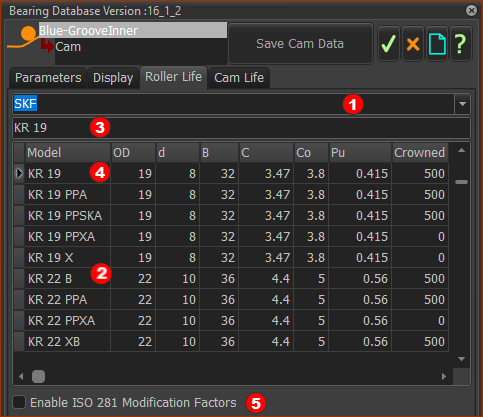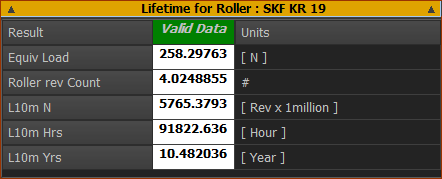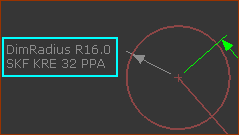2D-Cam > Roller Life tab
Notes:
Make sure a 2D-Cam or a Conjugate Cam FB is the power-source for the Follower-Part - see Configure Power Source The Follower-Roller bearing you select in this tab, controls the diameter of the Follower-Roller in the model. Other names for a Follower-Roller bearing are: Track-Roller, Track-Follower, Cam-Follower, ... . |
To Calculate the Roller Life, you must:
Parameters tab
Roller Life tab
Review the Roller's Lifetime |

2D-Cam dialog > Roller Life tab
Select a Manufacturer and Bearing Part-Number of Parameter
Roller Life tab
STEP 1: Select a Follower-Roller bearing Manufacturer
STEP 2: Select a Roller Bearing from the table
You can see immediately the Basic Rating Life, in the L10 for Roller: Part Number separator. |
To see these factors, select “Enable the ISO 281 Modification Factors” We calculate for you the and modification factors as you enter the parameters below.  ISO 281 Modification Factors
|
Filtration Ratio and Filtration Code |
|---|
; ISO 4406 Code; -/13/10 |
; ISO 4406 Code; -/15/12 |
; ISO 4406 Code; -/17/14 |
; ISO 4406 Code; -/19/16 |
Oil Filtered Off-Line
Select the Cleanliness Codes from the drop-down list box that represents the anticipated operating conditions, according to ISO 4406.
Filtration Code |
|---|
ISO 4406 Code; -/13/10 |
ISO 4406 Code; -/15/12 |
ISO 4406 Code; -/17/14 |
ISO 4406 Code; -/19/16 |
ISO 4406 Code; -/21/18 |
Grease
Select the Level of Contamination from the drop-down list box that best represents the operating conditions.
Level of contamination |
Operating Conditions |
|---|---|
High cleanliness |
Clean assembly with careful flushing; good sealing in relation to operating conditions; re-greasing carried out continuously or at short intervals Bearings, greased for life with effective sealing capacity in relation to operating conditions - for example, sealed bearings |
Normal cleanliness |
Clean assembly with flushing; good sealing in relation to operating conditions; re-greasing according to manufacturer’s specification Bearings, greased for life with proper sealing capacity in relation to the operating conditions - for example, shielded bearings |
Slight to typical contamination |
Clean assembly; moderate sealing capacity in relation to operating conditions; re-greasing according to manufacturer’s specifications |
Severe contamination |
Assembly in workshop; bearing and application not adequately washed after mounting; poor sealing capacity in relation to operating conditions; re-greasing intervals longer than recommended by manufacturer |
Very severe contamination |
Assembly in contaminated environment; inadequate sealing; long re-greasing intervals |
We calculate these parameters for you when you select a Roller, and/or enable ISO 281 factors.  Life for the seleced Roller(Cam-Follower Bearing) Basic Rating Life,This states that if the bearing load, , is equal to the Basic Dynamic Load Rating, , then there is a 90% reliability that the bearing survives 1 million rotations, if manufactured with commonly use high quality material, of good manufacturing quality, and operating under conventional operating conditions.
Modified Rating Life,
Operating LifeThe actual operating life is the life achieved by the bearing operating in its actual environment, which may differ significantly from the life we calculate. It is not possible to calculate the actual operating life, as there is a range of possible installation and operating conditions. One method to estimate the operating life is to compare the installation and operating conditions with similar applications. Possible factors that influence the Operating Life
|
Bearing Life Modification Factors
The Reliability Factor is constant for all application conditions. The drop-down list has the standard Reliability Factor percentages (90 to 99.95%), as given in ISO 281. Modified Life Rating (at reliability) (millions of revolutions)
|
The Life Modification factor, , is a complex interaction between Oil or Grease Viscosity Grade, Filtration, Contamination, Oil Operating Temperature, the Fatigue load capacity of the Roller, the rotational-speed of the Roller, and the diameter of the Roller. The equations given in ISO 281 to calculate these factors are empirical, complex, and interrelated. All of the factors, except , are a function of the bearing speed and bearing load. In a cam mechanism, the speed and load on the roller continually change. Therefore, we calculate for you the factors at each step and integrate them to find their equivalent values.
|
ISO 281 defines the fatigue load, , for a bearing as the load below which metal fatigue does not occur. With poor lubrication, or contamination of the lubricant, the bearing can fatigue at loads which are significantly below the fatigue limit,. For the fatigue limit to be a valid value, the lubricant film must fully separate the rolling elements from the raceways and that dents from contaminants from handling do not exist on the rolling surfaces. The contamination factor, takes into account how the level of solid particle contamination of the lubricant influences the calculated bearing fatigue life. The particles cause indentations in the rolling surfaces of the bearing, and these indentations increase the local contact stress, which reduces the expected fatigue life. • means perfectly clean conditions without any indentations. • means severely contaminated conditions resulting in pronounced indentations. In the SKF rating life model, contamination, designated by the contamination factor, , acts as a stress raiser, thereby reducing the fatigue load limit to . We then compare the reduced fatigue load limit, , to the actual bearing load, , to give a fatigue resistance value of •Conditions that are clean and a load that is less than the fatigue load limit give a high fatigue resistance value. •Conditions that are contaminated and a load that is more than the fatigue load limit give a low fatigue resistance value. The stress-raising influence of contamination on fatigue depends on a number of parameters, including: bearing size, relative lubricant condition, size and distribution of solid contaminant particles, and types of contaminants (soft, hard, etc.). Therefore, it is not meaningful to enter a value for the contamination factor that has general validity. If a catalog does not list the Fatigue Load Limit, and the mean bearing diameter is less than . (nearly all Follower-Roller Bearings are less than ), then we use this approximation: |
|
|
Roller and needle bearings, with a Mean Diameter < 100mm. |
|
Ball bearings, with a Mean Diameter < 100mm |
Mean Diameter = (Outside Diameter + Inside Diameter) / 2 |
|
The Viscosity Ratio, , indicates the quality of the lubricant film formation. The lubricant-film separates the raceway and rolling-elements. It is expressed as:
Note 1: Viscosity Ratio, , assumes that surface finish is for good quality Follower-Roller bearings. Note 2: An approximate relationship between Film Thickness Ratio and Viscosity Ratio, , is:
Notes: A Viscosity-Ratio < 0.1 is outside of the limits of ISO 281. It is near to metal-to-metal contact. A Viscosity-Ratio > 4 is the maximum that can be used by ISO 281. ISO 281 states that a Viscosity-Ratio = 4 if it is actually you calculate it to be greater than 4. A Viscosity-Ratio > 4 is getting too high for bearings. The needles or balls may slide and refuse to roll in the 'thick-oil', or the shearing of the oil may churn and increase the oil and bearing temperatures. A Viscosity-Ratio in the range of is approximately ideal. |
The Reference Kinematic-Viscosity, (sometimes called the Rated, or Required Viscosity) is the viscosity that is required to separate the surfaces, of the rolling elements and races in the Follower-Roller bearing.. It assumes that the oil is a mineral oil, with a Viscosity-Index of approximately 100. Synthetic oils can be used. |
|
if |
|
if |
|
|
- inside diameter of Follower-Roller |
- outside diameter of Follower-Roller |
|
We calculate for you the Viscosity, , at the Operating Temperature, , from the Viscosity at two other temperatures. Nearly always, the two other temperatures are and , but not necessarily. The lubricant's data-sheet usually specifies the Viscosity at ( ) and ( ) You must enter all four parameters in the dialog: •2 x temperature: and •2 x viscosity: and at temperature and •Operating-Temperature: . We calculate the Viscosity at the Operating-Temperature, . |
If a contaminant particle moves to the inside of a bearing the rollers (or balls), outer-race, and inner-race are prone to dent because of the small internal bearing clearances and the small rolling radii of the rollers (or balls). An indent leads to localized stress, which will decrease the life of the bearing. The contamination may even prevent the rollers (or balls) rotating. The contamination factors that reduce the lifetime of a Follower-Roller bearing are a function of the: •diameter of the Follower-Roller •lubricant film thickness (viscosity ratio, ) •size, type, and hardness of the particle contaminant. Guide values for the contamination factor are in the table below. They are typical levels of contamination for well lubricated bearings. Contamination and Lubrication Method. We can find for you the contamination factors with these lubrication methods:
|
|||||||||||||||||||||||||
Circulating oil lubrication with On-Line Filtration, before being supplied to the bearings.
|
|||||||||||||||||||||||||
Oil bath Lubrication, or Recirculating Oil Lubrication, with Off-Line Filtration.
NOTE Research concludes that it is difficult to accurately find the oil cleanliness especially if you analyze very clean oils. It is easy to pollute an oil-sample, with oil additives that precipitate into the oil and particle calculation. |
|||||||||||||||||||||||||
Grease Lubrication, Contamination Factors
|
|||||||||||||||||||||||||
Simplified Values of Oil Contamination Factor ,
Contamination Level for Grease Lubrication
|
The table below provides scale values as a function of particle concentration (particles/ml) - it is from ISO 4406 A three number code defines the amount of contamination for three particle sizes: 4, 6, and 14 μm. Each time a number increases by 1, the quantity of particles is doubled for a particular particle size. Example: ISO code = 21 / 19 / 17 This Contamination Class describes a fluid containing: •between 10,000 and 20 ,000 particles of ≥ 4 μm(c) per 1 ml sample •between 2,500 and 5 ,000 particles of ≥ 6 μm(c) per 1 ml sample •between 640 and 1 300 particles of ≥ 14 μm(c) per 1 ml sample If the leading number is missing, then that size of particle is not counted.
|
